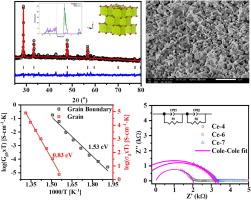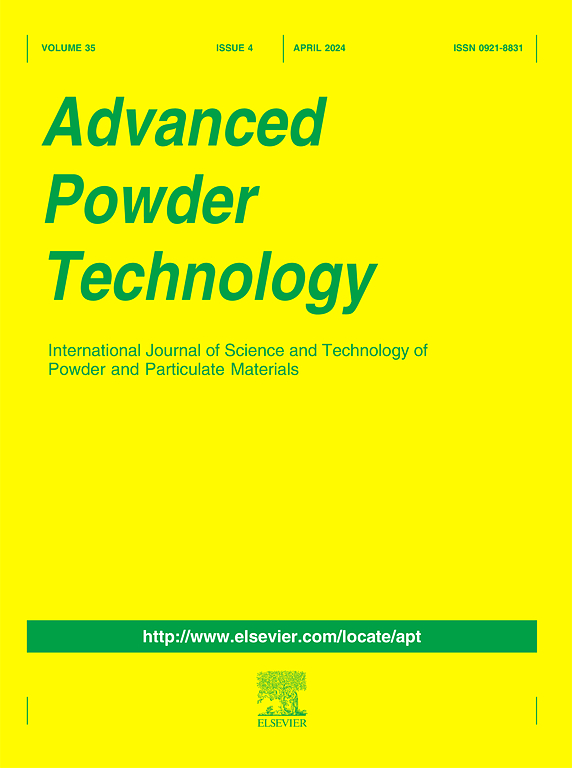煅烧温度对作为 IT-SOFC 应用固体电解质的 CeO2 纳米粒子的结构、微观结构和电气性能的影响
IF 4.2
2区 工程技术
Q2 ENGINEERING, CHEMICAL
引用次数: 0
摘要
本文全面讨论了通过溶胶-凝胶化学根合成的单相氧化铈(CeO2)纳米粒子在 400 ℃、600 ℃ 和 700 ℃ 等煅烧温度下的影响。对氧化铈的立方萤石结构进行的第一原理计算显示,Ce(5d) 和 O(2p) 对间接带隙 n 型半导体响应做出了贡献。结构研究还表明,CeO2 在立方结构中结晶时,晶体尺寸、位错密度和微应变随温度的变化而逐渐变化。傅立叶变换红外光谱(FTIR)中 Ce-O 在 437 和 541 cm-1 处的伸缩振动再次证实了所获样品的单相性。烧结颗粒的形态受不同煅烧温度的影响很大,例如低温煅烧的材料含有较大的颗粒,反之亦然。X 射线光电子能谱(XPS)研究显示了 Ce3+/Ce4+ 中的氧空位和 Ce 混合态。直流电导分析反映了阿伦尼乌斯型传输行为,揭示了两个传导区域:电子在区域-1(90-280°C)通过铈的退化位点,氧离子在区域-2(280-410°C)通过铈的退化位点。光谱图提取了影响电性能的晶粒和晶界贡献。由于界面上的空隙和无序结构,晶界的活化能高于晶粒,这与直流传导研究类似。样品 Ce-4′s 阻塞因子支持最高的直流导电率,接近 10-2 S/cm,接近 IT-SOFC 固体电解质导电率。因此,本研究可能会通过 IT-SOFC 中的晶粒/晶粒边界工程为氧化铈基固体电解质的商业化打开一扇窗。本文章由计算机程序翻译,如有差异,请以英文原文为准。

Effect of calcination temperature on the structural, microstructure, and electrical properties of CeO2 nanoparticles as a solid electrolyte for IT-SOFC application
This article comprehensively discusses the effect of calcination temperatures such as 400 °C, 600 °C, and 700 °C of the single-phase ceria oxide (CeO2) nanoparticles synthesized via sol–gel chemical root. The first principle calculation performed on the cubic fluorite structure of ceria oxide shows Ce(5d) and O(2p) contributed to the indirect band gap n-type semiconducting response. The structural studies also show the crystallization of CeO2 in the cubic structure with a gradual change in crystallite size, dislocation density, and micro-strain with temperature. The stretching vibration of Ce–O at 437 and 541 cm−1 in the Fourier-transform infrared (FTIR) spectrum reconfirms the monophasic nature of the obtained samples. The morphology of the sintered pellets is strongly affected by varying calcination temperatures, such as lower-temperature calcined materials containing larger grains and vice versa. The X-ray photoelectron spectroscopy (XPS) studies show oxygen vacancies and Ce’s mixed states in Ce3+/Ce4+. Arrhenius-type transport behavior was reflected through DC conductivity analysis that reveals the two conduction regions: electrons through Ce’s degenerate sites in the region-1 (90–280°C) and oxygen ions in the region-2 (280–410°C). The spectroscopic plots extracted the grain and grain boundary contribution, affecting the electrical properties. The grain boundary has a higher activation energy than the grains due to voids and disordered structures at the interface, similar to DC conduction studies. The sample Ce-4′s blocking factor supports the highest DC conductivity of almost 10−2 S/cm, close to IT-SOFC solid electrolyte conductivity. Therefore, the present study may open the window to commercialize ceria oxide-based solid electrolytes through grain/grain-boundary engineering in IT-SOFCs.
求助全文
通过发布文献求助,成功后即可免费获取论文全文。
去求助
来源期刊

Advanced Powder Technology
工程技术-工程:化工
CiteScore
9.50
自引率
7.70%
发文量
424
审稿时长
55 days
期刊介绍:
The aim of Advanced Powder Technology is to meet the demand for an international journal that integrates all aspects of science and technology research on powder and particulate materials. The journal fulfills this purpose by publishing original research papers, rapid communications, reviews, and translated articles by prominent researchers worldwide.
The editorial work of Advanced Powder Technology, which was founded as the International Journal of the Society of Powder Technology, Japan, is now shared by distinguished board members, who operate in a unique framework designed to respond to the increasing global demand for articles on not only powder and particles, but also on various materials produced from them.
Advanced Powder Technology covers various areas, but a discussion of powder and particles is required in articles. Topics include: Production of powder and particulate materials in gases and liquids(nanoparticles, fine ceramics, pharmaceuticals, novel functional materials, etc.); Aerosol and colloidal processing; Powder and particle characterization; Dynamics and phenomena; Calculation and simulation (CFD, DEM, Monte Carlo method, population balance, etc.); Measurement and control of powder processes; Particle modification; Comminution; Powder handling and operations (storage, transport, granulation, separation, fluidization, etc.)
 求助内容:
求助内容: 应助结果提醒方式:
应助结果提醒方式:


